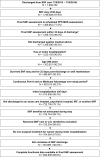Functional Status Is Associated With 30-Day Potentially Preventable Readmissions Following Skilled Nursing Facility Discharge Among Medicare Beneficiaries
- PMID: 29371127
- PMCID: PMC5911157
- DOI: 10.1016/j.jamda.2017.12.003
Functional Status Is Associated With 30-Day Potentially Preventable Readmissions Following Skilled Nursing Facility Discharge Among Medicare Beneficiaries
Abstract
Objectives: The objectives of this study were to determine the association between patients' functional status at discharge from skilled nursing facility (SNF) care and 30-day potentially preventable hospital readmissions, and to examine common reasons for potentially preventable readmissions.
Design: Retrospective cohort study.
Setting: SNFs and acute care hospitals submitting claims to Medicare.
Participants: National cohort of Medicare fee-for-service beneficiaries discharged from SNF care between July 15, 2013, and July 15, 2014 (n = 693,808). Average age was 81.4 (SD 8.1) years, 67.1% were women, and 86.3% were non-Hispanic white.
Measurements: Functional items from the Minimum Data Set 3.0 were categorized into self-care, mobility, and cognition domains. We used specifications for the SNF potentially preventable 30-day postdischarge readmission quality metric to identify potentially preventable readmissions.
Results: The overall observed rate of 30-day potentially preventable readmissions following SNF discharge was 5.7% (n = 39,318). All 3 functional domains were independently associated with potentially preventable readmissions in the multivariable models. Odds ratios for the most dependent category versus the least dependent category from multilevel models adjusted for patients' sociodemographic and clinical characteristics were as follows: mobility, 1.54 (95% confidence interval [CI] 1.49-1.59); self-care, 1.50 (95% CI 1.44-1.55); and cognition, 1.12 (95% CI 1.04-1.20). The 5 most common conditions were congestive heart failure (n = 7654, 19.5%), septicemia (n = 7412, 18.9%), urinary tract infection/kidney infection (n = 4297, 10.9%), bacterial pneumonia (n = 3663, 9.3%), and renal failure (n = 3587, 9.1%). Across all 3 functional domains, septicemia was the most common condition among the most dependent patients and congestive heart failure among the least dependent.
Conclusions: Patients with functional limitations at SNF discharge are at increased risk of hospital readmissions considered potentially preventable. Future research is needed to determine whether improving functional status reduces risk of potentially preventable readmissions among this vulnerable population.
Keywords: Mobility; chronic conditions; cognition; infection; self-care.
Copyright © 2017 AMDA – The Society for Post-Acute and Long-Term Care Medicine. Published by Elsevier Inc. All rights reserved.
Conflict of interest statement
The authors have no conflicts of interest to report.
Figures

Similar articles
-
Functional Status Is Associated With 30-Day Potentially Preventable Hospital Readmissions After Inpatient Rehabilitation Among Aged Medicare Fee-for-Service Beneficiaries.Arch Phys Med Rehabil. 2018 Jun;99(6):1067-1076. doi: 10.1016/j.apmr.2017.05.001. Epub 2017 Jun 3. Arch Phys Med Rehabil. 2018. PMID: 28583465 Free PMC article.
-
Functional Status Is Associated With 30-Day Potentially Preventable Readmissions Following Home Health Care.Med Care. 2019 Feb;57(2):145-151. doi: 10.1097/MLR.0000000000001047. Med Care. 2019. PMID: 30531524 Free PMC article.
-
Variation in Facility-Level Rates of All-Cause and Potentially Preventable 30-Day Hospital Readmissions Among Medicare Fee-for-Service Beneficiaries After Discharge From Postacute Inpatient Rehabilitation.JAMA Netw Open. 2019 Dec 2;2(12):e1917559. doi: 10.1001/jamanetworkopen.2019.17559. JAMA Netw Open. 2019. PMID: 31834398 Free PMC article.
-
Reducing Hospital Readmissions of Older Adults Pursuing Postacute Care at Skilled Nursing Facilities: A Scoping Review.Am J Occup Ther. 2022 Jan 1;76(1):7601180130. doi: 10.5014/ajot.2022.049082. Am J Occup Ther. 2022. PMID: 34997839
-
What Happens After a Patient Safety Event? Medical Expenditures and Outcomes in Medicare.In: Henriksen K, Battles JB, Marks ES, Lewin DI, editors. Advances in Patient Safety: From Research to Implementation (Volume 1: Research Findings). Rockville (MD): Agency for Healthcare Research and Quality (US); 2005 Feb. In: Henriksen K, Battles JB, Marks ES, Lewin DI, editors. Advances in Patient Safety: From Research to Implementation (Volume 1: Research Findings). Rockville (MD): Agency for Healthcare Research and Quality (US); 2005 Feb. PMID: 21249795 Free Books & Documents. Review.
Cited by
-
Positive Beliefs and the Likelihood of Successful Community Discharge From Skilled Nursing Facilities.Arch Phys Med Rehabil. 2021 Mar;102(3):480-487. doi: 10.1016/j.apmr.2020.09.375. Epub 2020 Sep 28. Arch Phys Med Rehabil. 2021. PMID: 32991871 Free PMC article.
-
Current Approaches in Telehealth and Telerehabilitation for Spinal Cord Injury (TeleSCI).Curr Phys Med Rehabil Rep. 2022;10(2):77-88. doi: 10.1007/s40141-022-00348-5. Epub 2022 Apr 26. Curr Phys Med Rehabil Rep. 2022. PMID: 35493027 Free PMC article. Review.
-
Function and Caregiver Support Associated With Readmissions During Home Health for Individuals With Dementia.Arch Phys Med Rehabil. 2020 Jun;101(6):1009-1016. doi: 10.1016/j.apmr.2019.12.021. Epub 2020 Feb 5. Arch Phys Med Rehabil. 2020. PMID: 32035139 Free PMC article.
-
Tele-rehabilitation using transcranial direct current stimulation combined with exercise in people with spinal cord injury: a randomized controlled trial.J Rehabil Med. 2025 May 7;57:jrm42353. doi: 10.2340/jrm.v57.42353. J Rehabil Med. 2025. PMID: 40331505 Free PMC article. Clinical Trial.
-
Transitional care from skilled nursing facilities to home: study protocol for a stepped wedge cluster randomized trial.Trials. 2021 Feb 5;22(1):120. doi: 10.1186/s13063-021-05068-0. Trials. 2021. PMID: 33546737 Free PMC article.
References
-
- RTI International and Abt Associates. [Accessed June 16, 2016];Draft Measure Specifications: Potentially Preventable Hospital Readmission Measures for Post-Acute Care. Available at: https://www.cms.gov/Medicare/Quality-Initiatives-Patient-Assessment-Inst....
-
- RTI International. [Accessed 8/23/2016];Measure Specifications for Measures Adopted in the FY 2017 SNF QRP Final Rule. Available at: https://www.cms.gov/Medicare/Quality-Initiatives-Patient-Assessment-Inst....
-
- [Accessed September 1, 2016];Improving Medicare Post-Acute Care Transformation Act of 2014, PL 113-185. https://www.govtrack.us/congress/bills/113/hr4994.
-
- Berkowitz RE, Fang Z, Helfand BK, Jones RN, et al. Project ReEngineered Discharge (RED) lowers hospital readmissions of patients discharged from a skilled nursing facility. J Am Med Dir Assoc. 2013;14:736–740. - PubMed
-
- Park HK, Branch LG, Bulat T, Vyas BB, et al. Influence of a transitional care clinic on subsequent 30-day hospitalizations and emergency department visits in individuals discharged from a skilled nursing facility. J Am Geriatr Soc. 2013;61:137–142. - PubMed
Publication types
MeSH terms
Grants and funding
LinkOut - more resources
Full Text Sources
Other Literature Sources
Medical

